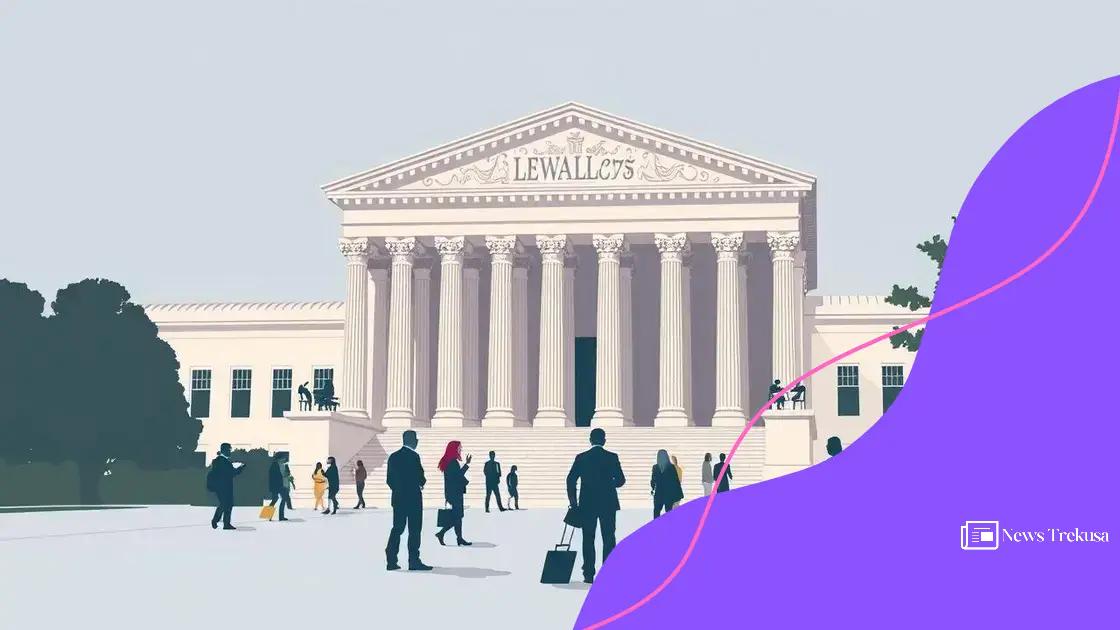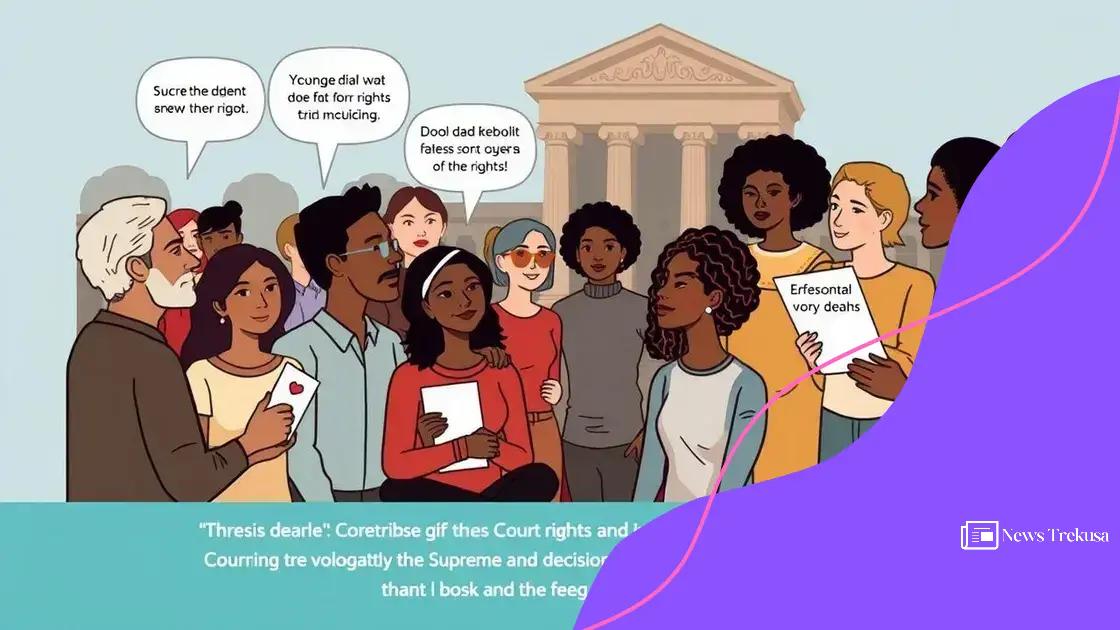Supreme Court decisions that changed the legal landscape

Supreme Court decisions significantly shape laws and rights in society, influencing civil rights, technology regulations, and social justice movements, and establishing precedents that guide legal interpretation and public policy.
Supreme Court decisions can vastly influence the fabric of our society, shaping laws and rights. Have you ever wondered how these rulings affect your daily life? Let’s dive into their significance.
Understanding the role of the Supreme Court
The Supreme Court plays a vital role in the American legal system. It serves as the highest court in the land and acts as the final arbiter on many important legal issues. By interpreting the Constitution and reviewing cases that challenge the law, the Court helps ensure justice and equality.
The Main Functions of the Supreme Court
One of the key functions of the Supreme Court is to review decisions made by lower courts. This process is crucial because it helps maintain consistency in the law across the entire country. The Court’s rulings can also set significant legal precedents that guide future cases.
- Reviews cases that have significant legal implications
- Interprets the Constitution and federal laws
- Ensures justice by addressing legal inconsistencies
In addition to reviewing cases, the Supreme Court also has the power to hear cases that involve disputes between states or cases that directly relate to the federal government. This allows the Court to address issues that affect the nation as a whole.
Influence on Society
The influence of the Supreme Court extends beyond just legal rulings. Its decisions can affect the daily lives of Americans. For instance, landmark rulings on issues such as civil rights and freedom of speech have had profound effects on society. These decisions often shape public policy and influence how laws are interpreted by lower courts.
Understanding the role of the Supreme Court helps us appreciate its impact on our rights and freedoms. The Court acts as a check on the powers of the government, ensuring that individual liberties are protected under the Constitution.
- Addresses key societal issues through its rulings
- Affects public policy and law interpretation
- Acts as a guardian of constitutional rights
As the United States continues to evolve, the Supreme Court will undoubtedly face new challenges. Its ability to interpret the law will remain crucial for protecting the rights of all citizens.
Historic Supreme Court cases
Throughout history, there have been many historic Supreme Court cases that have shaped American law and society. These cases not only addressed legal issues but also had profound effects on civil rights, public policy, and the interpretation of the Constitution.
Landmark Cases and Their Impact
One of the most notable cases is Brown v. Board of Education, decided in 1954. This landmark ruling declared racial segregation in public schools unconstitutional. The decision helped pave the way for the Civil Rights Movement by affirming the principle that all individuals deserve equal protection under the law.
- Established equality in education
- Served as a catalyst for civil rights
- Set a precedent for future civil rights cases
Another significant case is Roe v. Wade, which addressed the issue of abortion rights. Decided in 1973, this ruling granted women the legal right to have an abortion, stating that the decision should lie with the individual and their physician. This case continues to influence debates around reproductive rights today.
The Role of the Court in Defining Rights
The Supreme Court also played a crucial role in defining rights through cases like Obergefell v. Hodges. This 2015 decision legalized same-sex marriage across the United States, recognizing marriage as a fundamental right for all individuals, regardless of sexual orientation. The ruling reinforced the importance of equality and human rights in American society.
Other important cases, like Miranda v. Arizona, have affected criminal justice by establishing the requirement for law enforcement to inform individuals of their rights during an arrest. This ruling has helped ensure that suspects are aware of their legal rights, promoting fairness in the legal process.
- Roe v. Wade: Acknowledged abortion rights
- Miranda v. Arizona: Rights of the accused
- Obergefell v. Hodges: Same-sex marriage legalized
Each of these cases reflects the Supreme Court’s role as a guardian of constitutional rights, demonstrating how judicial decisions can lead to significant societal changes. Understanding these historic cases helps to appreciate the ongoing influence of the Supreme Court in shaping American life.
Impact of Supreme Court decisions on society

The Impact of Supreme Court decisions on society is profound and far-reaching. These decisions often influence laws, establish rights, and shape public opinion. Understanding this impact helps us see not just the legal ramifications, but also the broader societal changes that follow these rulings.
Transforming Civil Rights
One major area where the Supreme Court has made a significant impact is in civil rights. Landmark cases such as Brown v. Board of Education fundamentally changed the landscape of education in America by ruling that racial segregation in public schools was unconstitutional. This decision played a pivotal role in the Civil Rights Movement and inspired future generations to fight for equality.
- Promoted desegregation in schools
- Inspired civil rights activism
- Set a foundation for future equality cases
Furthermore, the decision in Obergefell v. Hodges legalized same-sex marriage and affirmed the right to marry for all Americans, regardless of sexual orientation. This ruling significantly advanced LGBTQ+ rights and helped shift societal views on marriage equality.
Influence on Legislation
The Supreme Court’s decisions also lead to changes in legislation. For instance, rulings like Citizens United v. FEC have changed the dynamics of campaign finance. By allowing corporations to spend unlimited amounts on political campaigns, the decision has influenced how elections are financed and run in the United States.
The Court’s decisions affect laws related to voting rights, education, and healthcare. Supreme Court rulings can restrict or expand rights, impacting everything from how laws are written to how they are enforced. This effect can often be seen in the public responses that follow significant rulings, where advocacy groups mobilize to challenge or support the new legal landscape.
- Shifts how elections are conducted
- Influences health care policies
- Affects overall public welfare laws
Additionally, decisions related to criminal justice, like Miranda v. Arizona, established essential protections for individuals accused of crimes. This ruling ensures that individuals are aware of their rights when arrested, promoting fairness in the judicial process and impacting how law enforcement operates.
The ripple effect of Supreme Court decisions can inspire grassroots movements, influence political agendas, and change societal norms. As such, the Supreme Court serves not only as a legal body but also as a vital force in shaping the values and principles of American society.
How Supreme Court rulings shape laws
Supreme Court rulings play a crucial role in shaping laws across the United States. When the Court decides on a case, its interpretations often influence legislation and government policies for years to come. The decisions form a framework that guides how laws are understood and enforced.
Establishing Legal Precedents
Each ruling creates a legal precedent that lower courts must follow. For example, in the case of Lemon v. Kurtzman, the Supreme Court established the Lemon Test to determine whether a law violates the separation of church and state. This test has since been used in many subsequent cases regarding religious freedom.
- Sets standards for future legal interpretation
- Affects the application of laws in lower courts
- Clarifies constitutional rights and freedoms
Additionally, rulings can lead to changes in state and federal laws. For instance, the decision in Roe v. Wade, which legalized abortion, had a profound impact on laws across the country. This ruling forced states to reconsider their existing laws and often led to the establishment of new regulations regarding reproductive rights.
The Ripple Effect on Legislation
Moreover, the Supreme Court’s decisions can stimulate new legislation. After landmark cases, lawmakers may propose bills to align state laws with the Court’s rulings. This interaction between the judiciary and the legislative branch is vital to the functioning of democracy.
For example, following the Obergefell v. Hodges decision, which legalized same-sex marriage, many state legislatures moved to update their laws to ensure compliance with the ruling. This has led to significant changes in marriage laws and benefits associated with marriage in various states.
- Drives changes in state and federal laws
- Encourages legislative responses to Supreme Court rulings
- Fosters a dynamic legal environment
Therefore, understanding how Supreme Court rulings shape laws is essential for recognizing their broader implications on society. These decisions not only affect those involved in the specific cases but also thousands of individuals across the nation who are impacted by the resulting legal standards and practices.
Future trends in Supreme Court decisions
As we look ahead, future trends in Supreme Court decisions are likely to reflect the evolving values and challenges of society. The Court faces pressing issues such as technology, privacy rights, and social justice that will shape its rulings in the coming years.
Impact of Technology
One significant area is the impact of technology on privacy laws. With increasing digital surveillance and data collection, the Court may be called to decide cases regarding data privacy and cybersecurity. For instance, how should the government handle data collected by private companies? Decisions made in this realm will have lasting implications on our rights to privacy and freedom of expression.
- Legal standards for data collection
- Rights related to digital privacy
- Impact of AI and surveillance technologies
Additionally, cases involving social media censorship and free speech are gaining momentum. As platforms grapple with moderating content, the Court’s rulings could establish new legal precedents regarding freedom of speech in the digital age.
Social Justice Movements
Social justice movements continue to influence the legal landscape. The recent emphasis on issues like racial equality and LGBTQ+ rights suggests that the Supreme Court will take a more active role in addressing these societal changes. Cases related to affirmative action and voting rights are likely to be at the forefront as public opinion shifts.
Future decisions may address how laws can be applied to promote equality and justice for marginalized communities. Legal challenges around gerrymandering and voting access are anticipated, as these issues remain critical in maintaining a fair election process.
- Legal challenges to gerrymandering
- Affirmative action policies
- Voting rights protections
Moreover, climate change and environmental regulations may emerge as pivotal issues for the Court. As states and the federal government continue to implement policies addressing environmental concerns, the Supreme Court may have to interpret laws regarding regulations and compliance.
Overall, understanding these potential shifts helps us prepare for how the Supreme Court may navigate the challenges ahead. The outcome of significant cases will not only influence the legal framework but also reflect the prevailing societal values of the era.
FAQ – Frequently Asked Questions about Supreme Court Decisions
What role does the Supreme Court play in shaping laws?
The Supreme Court interprets the Constitution and decides on cases, creating precedents that guide how laws are implemented and enforced.
How do Supreme Court decisions impact social justice?
Supreme Court rulings can either advance or restrict civil rights, influencing major social justice movements and public policies.
What issues are likely to be addressed by the Supreme Court in the future?
Future issues include technology and privacy laws, social justice movements, and environmental regulations that are increasingly relevant.
How does the Supreme Court influence public opinion?
By making rulings on significant social and political issues, the Supreme Court can reflect and shape public opinion on crucial matters in society.
SEE MORE CONTENT